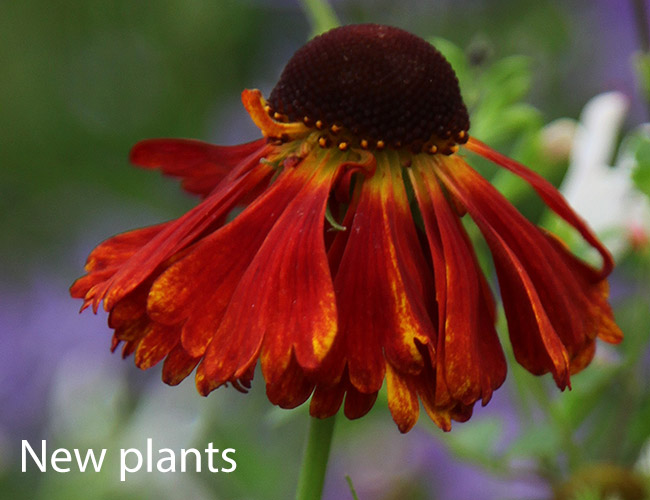|
Take heleniums for instance. Many struggle to grow H. autumnale ‘Moerheim Beauty’ well, because it needs warmth and summer moisture to do well. It was raised at the Moerheim Nursery in the Netherlands in the 1930's and the double layer of mahogany-red to brownish petals are rather like a frilly petticoat. ‘Sahin’s Early Flowerer’, which emerged in the 1990’s, is far earlier, easier and more inclined to repeat flower. The orange flowers dazzle the eyes, because each one is slightly different in form and colour. It was originally spotted in a field containing thousands of seedlings by the late Dutch seedsman, Kaas Sahin. He noticed one of his seedlings flowered for a much longer period than the others and asked Bob Brown (of Cotswold Garden Plants) to develop the plant. He named it after his friend Kaas and now this superb plant is grown all over the world.
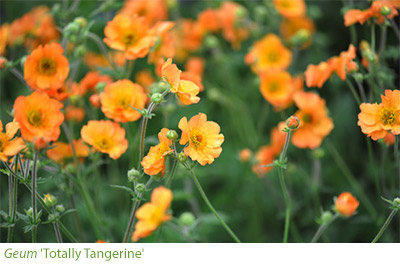
Geums have also had an exciting journey in recent years and several plant raisers have been breeding complex hybrids that flower over many months, due to having a sterile tendency. If a plant can’t set seeds, it continues to flower on and on, which is good news for gardeners. ‘Totally Tangerine’, which emerged almost twenty years ago now, begins to send out its long wands of soft, pumpkin-orange frilly flowers in May and then keeps on going until October or later. It’s happy in any soil and the early flowers are superb used with grey-blue Amsonia. Or you can use annual blue cornflowers (Centaurea cyanus) in summer.
 Now there’s a similar red-flowered geum, ‘Scarlet Tempest’, raised by Scotland’s Elizabeth MacGregor. It flowers over many months and last year it came second in the RHS Garden Plant of the Year Competition held at the Chelsea Flower Show. A touch of warm-red, just a glimmer rather than a lot, enhances the garden. It makes the greens richer, and the blues bluer. Look at any great painting and there is always a glimmer of red and the technique works just as well in the garden. Elizabeth Macgregor also raised Anemone ‘Wild Swan’, which was the RHS Garden Plant of the Year in 2011. Now there’s a similar red-flowered geum, ‘Scarlet Tempest’, raised by Scotland’s Elizabeth MacGregor. It flowers over many months and last year it came second in the RHS Garden Plant of the Year Competition held at the Chelsea Flower Show. A touch of warm-red, just a glimmer rather than a lot, enhances the garden. It makes the greens richer, and the blues bluer. Look at any great painting and there is always a glimmer of red and the technique works just as well in the garden. Elizabeth Macgregor also raised Anemone ‘Wild Swan’, which was the RHS Garden Plant of the Year in 2011.
Geums are riding high and new Dutch breeding is providing larger flowers on shorter stems. ‘Censation Apricot Pearl’, one of the Censation Series, has soft milky apricot flowers that need a darker contrast to stop them looking insipid. You could grow this near coppery rose foliage, or marry it up with a darkish heuchera such as ‘Obsidian’. There’s also a Cocktail Series with frilly large flowers. These plants look their best in bright shade and could be containerised as a specimen, because their flowers are so multi-layered.

You could also try a new acid-loving fern in a rugged container, as long as you use ericaceous compost. Blechnum brasiliense ‘Volcano', is a tropical Brazilian tree fern that survives temperatures as low as -5C (23F). Sometimes known as the Red Dwarf tree fern, it thrives on warmth and humidity in the rainforest. The new foliage is a purplish red, hence the name ‘Volcano’. It needs to be kept away from full sun and it loves humidity. If your garden’s very urban and in the southern half of the country you could tuck it up against the house wall - somewhere where it misses winter. In cold winters though, it would need bubble wrap and fleece. If you’re colder move it to a cool frost-free greenhouse, or conservatory in the winter, and keep it on the dry side.
 You could also containerise ‘Taiga’, a Japanese-bred showy purple and greenish white clematis, which could be mistaken for a passion flower at first sight. It flowers late, producing lots of double flowers on a compact plant that will reach roughly a metre. The most double flowers appear later. Choose a frost-proof container that stays cool and place the container out of full sun because clematis hate warm roots. Or you could shade your clematis pot by placing another in front. Both pots should be standing on pot feet to allow excess rainwater to escape. Feed with a potash-rich water-on tomato food once the buds set. Containerised plants need fresh compost every third year, or before if the plant begins to look tired, so choose an accessible pot with sides that are straight or slightly splayed out at the top for ease of removal. Use a rich loam-based compost such as John Innes no 3. Remove the plant carefully in spring and tease away the compost and replant. You could also grow ‘Taiga’, which is Japanese for river, on a south-facing wall. Other new clematis include the spring-flowering 'Diamond Anniversary’, the late-summer pick ‘Wonderful’ and the large-flowered, red-violet ‘Paradiso’. You could also containerise ‘Taiga’, a Japanese-bred showy purple and greenish white clematis, which could be mistaken for a passion flower at first sight. It flowers late, producing lots of double flowers on a compact plant that will reach roughly a metre. The most double flowers appear later. Choose a frost-proof container that stays cool and place the container out of full sun because clematis hate warm roots. Or you could shade your clematis pot by placing another in front. Both pots should be standing on pot feet to allow excess rainwater to escape. Feed with a potash-rich water-on tomato food once the buds set. Containerised plants need fresh compost every third year, or before if the plant begins to look tired, so choose an accessible pot with sides that are straight or slightly splayed out at the top for ease of removal. Use a rich loam-based compost such as John Innes no 3. Remove the plant carefully in spring and tease away the compost and replant. You could also grow ‘Taiga’, which is Japanese for river, on a south-facing wall. Other new clematis include the spring-flowering 'Diamond Anniversary’, the late-summer pick ‘Wonderful’ and the large-flowered, red-violet ‘Paradiso’.

A showy plant like 'Taiga' needs a plain accompaniment and the grass-like plant Liriope muscari ‘Okina’, a pale-leaved form of turf lily, has strappy white foliage that looks almost silvery in good light. Blue muscari-like spikes of flower appear in autumn, although Liriope is mainly grown for its foliage. It prefers acid soil, so use an ericaceous compost when potting up. Or it could make a gentle edging for a woodland garden, especially if you have acid soil. There’s also a new purple-leaved switch grass, Panicum virgatum ‘Purple Breeze’, that’s best grown in full sun on fertile soil. You could team it up with Lobelia ‘Compton Pink’, a moisture-loving perennial not to be confused with bedding lobelias that trail, although all have three lobes on the flowers. 'Compton Pink’, a recent lobelia, will rise to 45cm, and there’s a hint of darker cyclamen-pink in the centre of each flower.
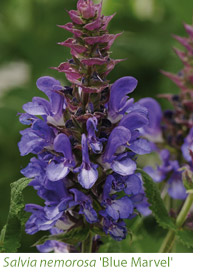 Pastel shades are always popular in a summer garden and Scabiosa incisa ‘Kudo’ has large pink flowers that are perfect for cutting. It’s a Japanese repeat-flowering scabious that does not set seed. It's truly perennial and flowers hover above a neat mound of foliage making it perfect for a smaller garden. Salvia nemerosa ‘Blue Marvel’ is a repeat-flowering hardy perennial salvia with large royal-blue flowers that keep coming until the first frosts. It’s just 30cm tall - so another candidate for a pot or a small garden. Pastel shades are always popular in a summer garden and Scabiosa incisa ‘Kudo’ has large pink flowers that are perfect for cutting. It’s a Japanese repeat-flowering scabious that does not set seed. It's truly perennial and flowers hover above a neat mound of foliage making it perfect for a smaller garden. Salvia nemerosa ‘Blue Marvel’ is a repeat-flowering hardy perennial salvia with large royal-blue flowers that keep coming until the first frosts. It’s just 30cm tall - so another candidate for a pot or a small garden.
Border phloxes (Phlox paniculata) have had a great revival because they perform in August, between the summer and autumn, and their flowers are fragrant and insect friendly. ‘Larissa’ is a purple-eyed pink with white ‘pips’ and the individual flowers form a densely packed domed panicle that resists the rain. ‘Alexandra’ is white-eyed hot-pink that’s part of the Russian Lady series. The flowers won’t fade, their foliage resists mildew and they reach up to 90cm, so they mix well in summer borders. 'Younique Mauve’ is a shorter phlox with white markings on mid-purple petals. All phloxes pick well and in the past the border phlox was a stalwart of the old walled garden - supplying cut flowers in summer and autumn.
|
Things to do
 |
Sow seeds

There is still time to sprinkle seeds on the ground, and they could include calendula, nigella, zinnia and nasturtium. Rake through the soil, water it well, sprinkle and keep watering until the seeds appear.
|
 |
Take cuttings
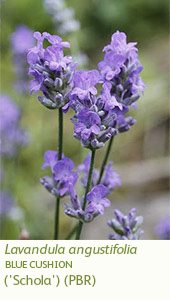
Soft-wood cuttings of fuchsias, lavenders, penstemons etc can be taken now. Look for semi-ripe wood produced this year. It should feel pliable, but not soft and new. Cut away three to four inch pieces and remove any flower buds. Trim underneath the leaf node - where the leaves appear - and then reduce any overly large leaves. Fill half-size sturdy plastic seed trays with coarse horticultural sand (or grit sand) and plunge the cuttings into the sand so that most of the cutting is submerged. Pot the cuttings up in gritty compost once they root. If you have cuttings still in trays at the end of August, leave them there until the following spring, pot up and plant out when rooted.
|
 |
Feed
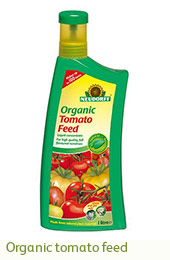
Start to feed containers that are filled with summer bedding with a potash-rich tomato food to encourage more flower. Once a fortnight is usually the norm, but do read the manufacturers instructions.
|
 |
Find and destroy
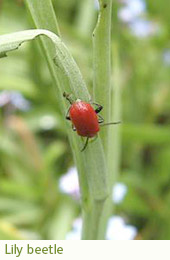
Lily beetles have become quite widespread now, and they can munch through lilies and fritillarias in record time. Pick off any of the adults, grubs or orange-red eggs if you spot them.
|
 |
Pot up tender plants
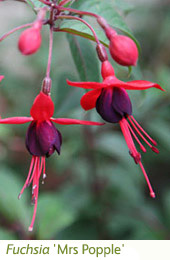
Plant up pots and containers now that frost is unlikely. Order tender plants such as fuchsias, penstemons and salvias and plant them now so that they develop good root systems.
|
|
|
| |
|



